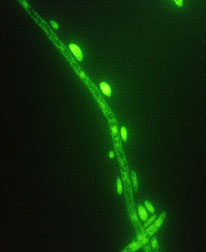Antifungal Peptides Could Protect Cotton
During times of drought, physiological stress can weaken a cotton plant's natural defense system against microbes such as the toxin-producing fungus Aspergillus flavus.
But in New Orleans, Louisiana, Agricultural Research Service scientists are working on a backup defense for the crop. They are studying the fungicidal properties of small proteins called peptides that are found in moths and other organisms. Once they've identified a potent peptide of just the right size and shape, the researchers will introduce into cotton plants the gene for making the peptide to fight infection.
Besides safeguarding the plant against disease, the approach could ease the need for using chemical fungicides. In 1996, the latest year for which statistics are available, growers applied 397,000 pounds of fungicide to 6 percent of the 12 million acres of cotton produced in the eight top cotton-growing states.
Microbiologist Anthony J. De Lucca and chemist John M. Bland are part of the ARS team investigating the fungicidal peptides as a potential alternative. Of particular interest are those lethal to species of Aspergillus, Fusarium, and other virulent fungi that attack agriculturally important crops like cotton, corn, peanuts, and tree nuts.
One of the most serious offenders is A. flavus.
During droughts, this fungus can invade the seed of cotton or other crops and produce a harmful substance called aflatoxin. It is so potent that no crop with more than 20 parts per billion (ppb) can be sold for animal feed. Twenty ppb is equivalent to 1 inch in 16,000 miles. Still, even these minute quantities can mean major losses for cotton growers or lint and seed processors.
Fusarium fungi, for their part, inflict costly root rots and seedling diseases.
According to De Lucca, one peptide with antifungal promise comes from a surprising source: the cecropia moth. In test tube experiments, the cecropin-A peptide killed 100 percent of dormant and germinating spores of Fusarium fungi--and nearly all germinating spores of A. flavus--within 30 minutes.
"It doesn't take long for the peptides to work," De Lucca says. "They cause pores to form in the fungal wall, resulting in leakage of cell contents and death."
He and Bland are studying a wide range of peptide sources, including frog skin, plant seeds, and soil-dwelling bacteria. They also examine synthetic peptides, and they test the peptides for resistance to degradation by natural cotton plant enzymes.
Once they find suitable candidates, ARS molecular biologists Jeffrey W. Cary and Kanniah Rajasekaran will step in and design proper gene constructs to code for desired peptides and will introduce them into cotton cells. Then, from the engineered cotton cells, they will grow mature plants for greenhouse studies.
One challenge, De Lucca notes, is to find the smallest peptides possible having a simple, linear structure. "The larger and more complicated a peptide's structure, the harder it is to successfully encode into the plant genome," he says.
Once that's accomplished, though, the researchers will be a step closer to evening the odds in cotton's favor, especially against the likes of Aspergillus.--By Jan Suszkiw, Agricultural Research Service Information Staff.
Anthony J. De Lucca, John M. Bland, Jeffrey W. Cary, and Kanniah Rajasekaran are at the USDA-ARS Southern Regional Research Center, P.O. Box 19687, New Orleans, LA 70179; phone (504) 286-4253, fax (504) 286-4419.
"Antifungal Peptides Could Protect Cotton" was published in the June 1998 issue of Agricultural Research magazine. Click here to see this issue's table of contents.







